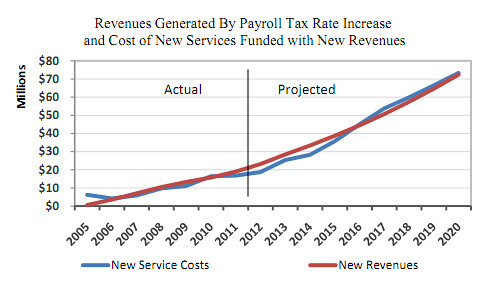Contribution Rates Stay Steady While Benefits Increase

Connecticut workers got some good news at the start of 2025. The CT Paid Leave Authority announced that the 2025 premium rate for the CT Paid Leave State Plan will remain at 0.5%, keeping the cost the same for employees. But here’s the kicker – while you’re paying the same amount, your potential benefits just went up. The maximum weekly benefit amount will increase to $981 from $941.40 effective January 1, 2025. It’s like getting a raise without actually getting a raise – your dollar goes further when you need it most.
Higher Wage Cap Means More Coverage

If you’re a higher earner, you’re probably contributing more to the system now, but it’s not necessarily a bad thing. The contribution rate will remain at 0.5% up to the federal Social Security wage contribution cap, which is $176,100 in 2025 (2024: $168,600). This means if you make the maximum amount, an employee’s maximum contribution to the state’s plan will be $880.50 in 2025 (2024: $843). That’s only about $37 more per year – roughly three bucks a month – for expanded coverage.
Minimum Wage Boost Drives Benefit Increases

The reason your benefits are going up isn’t just government generosity – it’s tied to Connecticut’s minimum wage increase. Connecticut employers are legally obligated to pay employees the new hourly wage of $16.35 on and after Jan. 1, 2025. Since the maximum weekly benefit of 60 times the Connecticut minimum wage, your potential payout automatically increases. The minimum wage increases to $16.35/hour, and as a result the max benefit amount will increase to $981.00/week. Simple math that works in your favor.
Massive Program Success Numbers

The Connecticut Paid Leave program isn’t just surviving – it’s thriving. 219K Approved Applications, $1.15B Benefits Paid, $666M Trust Fund Balance, 147K Registered Employers paint a picture of a program that’s actually working. The Connecticut Paid Leave Authority reports an approval rate of approximately 80 percent. As of January 2025, more than 200,000 applications have been approved. These aren’t just numbers on a page – they represent real people who got help when they needed it most.
Small Employers Now Required to Participate

The program is expanding beyond big companies. Under CT Paid Leave, employers with as few as one employee in Connecticut are required to provide 12 weeks of paid leave. This is a game-changer for folks working at small businesses who previously had no safety net. To be eligible, an employee is required to work for a covered employer for three months and have earned at least $2,325 in a “base period”. The bar isn’t set impossibly high – if you’re working regularly, you’re probably covered.
Extended Family Definition Expands Coverage

Connecticut’s definition of “family” got a major upgrade that actually makes sense for modern families. Under CT Paid Leave, the definition of “family member” also includes a parent-in-law, sibling, grandchild, grandparent, or an individual related to the employee by blood or whose close association to the employee is the equivalent of those family relationships. This isn’t just bureaucratic language – it means you can take leave to care for your grandmother, your brother, or even that person who’s been like family to you. The state finally caught up with how real families work.
Benefits Structure Favors Lower-Income Workers

The benefit calculation isn’t a flat rate – it’s designed to help those who need it most. Eligible employees will receive 95% of their base weekly earnings if they earn less than or equal to 40 times the state minimum wage. This means if you’re making closer to minimum wage, you get nearly your full paycheck while on leave. The compensation benefit will be determined on a sliding scale, so lower-paid employees will receive a maximum benefit of up to 95 percent of their regular weekly pay. It’s progressive by design, not by accident.
Employer-Funded Alternative Plans Allowed

Companies don’t have to stick with the state plan if they want to do better. An employer may apply to the Authority requesting an exemption as long as the employer is able to demonstrate that it will be able to satisfy its CT PFML Act obligations through its private plan. However, the private program must provide equivalent benefits and meet other specific requirements, including approval by a majority vote of the employer’s employees. The catch? Private plans must have the same, or better, benefits and not cost employees more than the state program. You can’t get a worse deal just because your boss wants to save money.
Sick Leave Expansion Creates Double Protection

Connecticut didn’t stop at family leave – they’re expanding sick leave too. On May 28, 2024, Connecticut’s governor signed legislation expanding the Connecticut sick pay law. The expanded sick leave rules will apply beginning January 1, 2025. Beginning January 1, 2025, the law expands to employees in nearly every occupation, not just service workers. The CT paid leave expansion will drop to the following thresholds: January 1, 2025: All employers with 25 or more employees must provide paid sick leave. By 2027, even one-person businesses will have to provide sick leave.
Faster Accrual Rates Benefit Workers

The new sick leave rules aren’t just about more coverage – they’re about faster accrual too. Under Connecticut’s paid sick leave law, employees immediately accrue one hour of paid sick leave per 40 hours worked. Beginning January 1, 2025, employees accrue one hour of sick time for every 30 hours worked, up to a maximum of 40 hours per year. Instead of working 40 hours to earn one hour of sick time, you now only need to work 30. This change allows employees to accrue paid sick leave more quickly, which means you don’t have to wait as long to build up your safety net.
Program Reduces Financial Stress

The numbers tell a story of financial relief for Connecticut families. Since the program began issuing benefits in 2022, it has paid out over $1 billion to Connecticut workers. The program is supported by a trust fund with a balance of $632 million and more than 149,000 registered employers statewide. This isn’t a program running on fumes – it’s financially stable and growing. People who are no longer forced to choose between their own healing or putting food on their table, and being a caregiver for their loved ones or paying the electric bill represents the real-world impact of having this safety net.
National Context Shows Connecticut’s Leadership

Connecticut is way ahead of most states when it comes to paid family leave. As of 2023, Bureau of Labor Statistics data show that only about 1 in 4 employees (27 percent) in the private sector workforce have access to paid family leave. Thirteen states have passed paid family and medical leave laws: California, Colorado, Connecticut, Delaware, Maine, Massachusetts, Maryland, Minnesota, New Jersey, New York, Oregon, Rhode Island, and Washington state, as well as Washington, D.C. Connecticut is part of an elite group of states that decided workers shouldn’t have to choose between their paycheck and their family’s wellbeing.
Connecticut’s paid family leave program keeps getting stronger without getting more expensive for workers. The state managed to increase benefits while keeping contribution rates flat, expand coverage to more families and workplaces, and maintain a healthy financial foundation. For a program that’s only been around since 2022, that’s pretty impressive progress. What other state programs can you say actually got better and cheaper at the same time?







